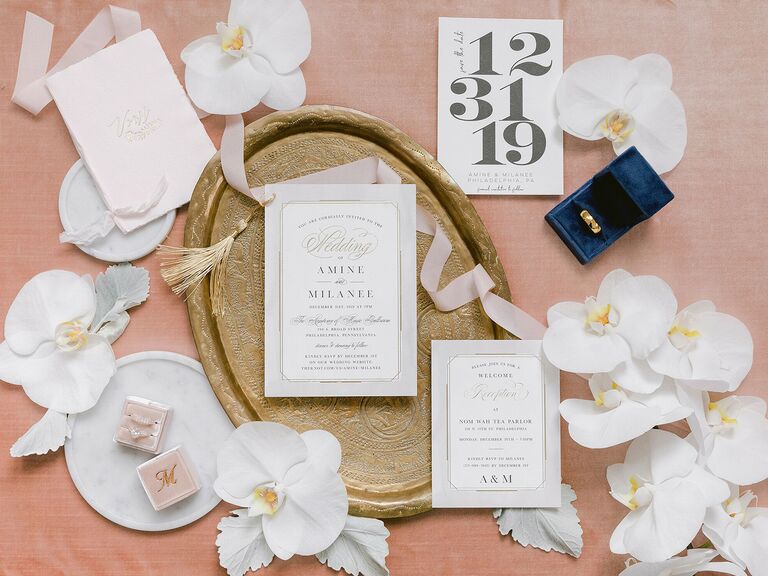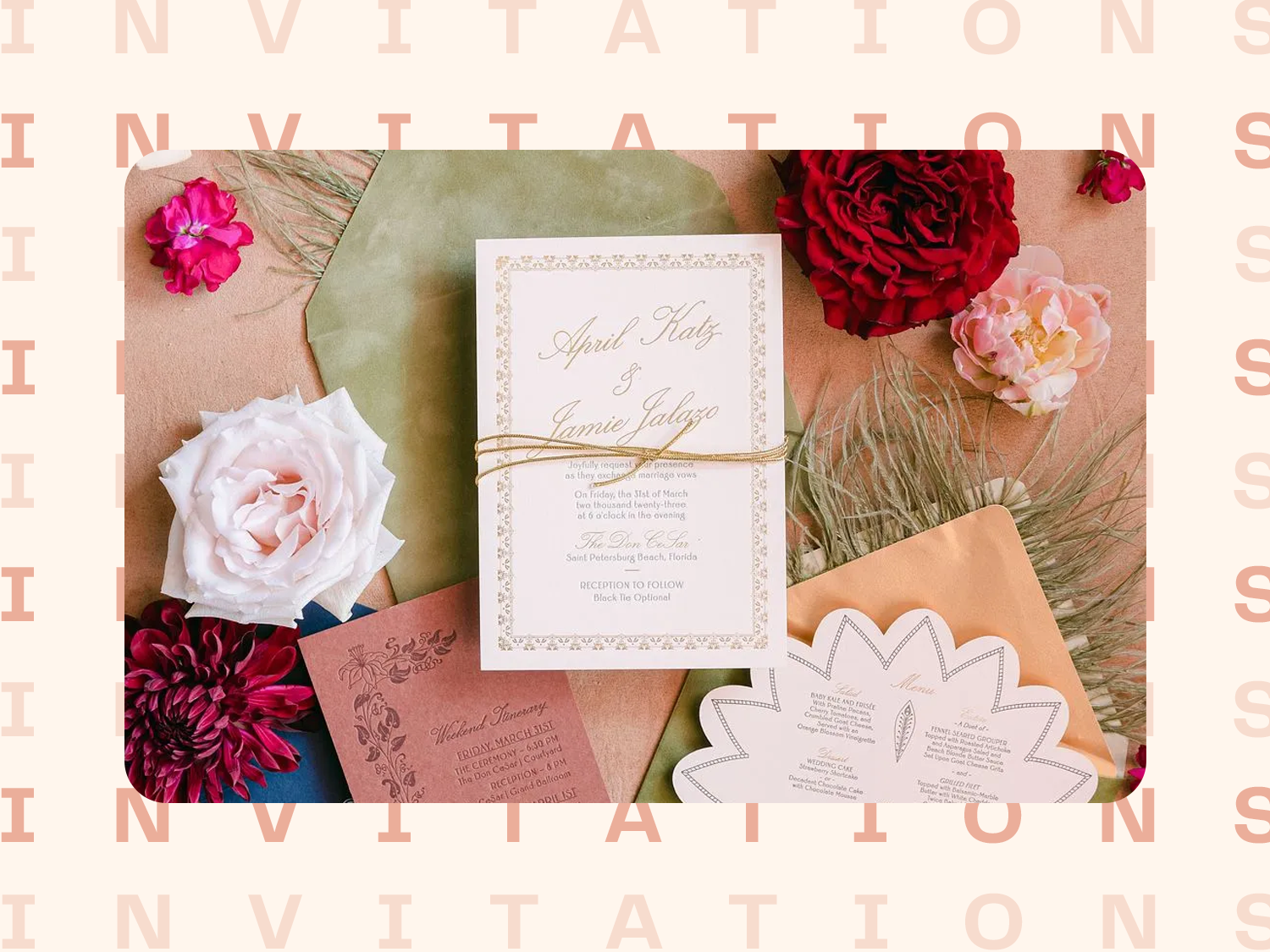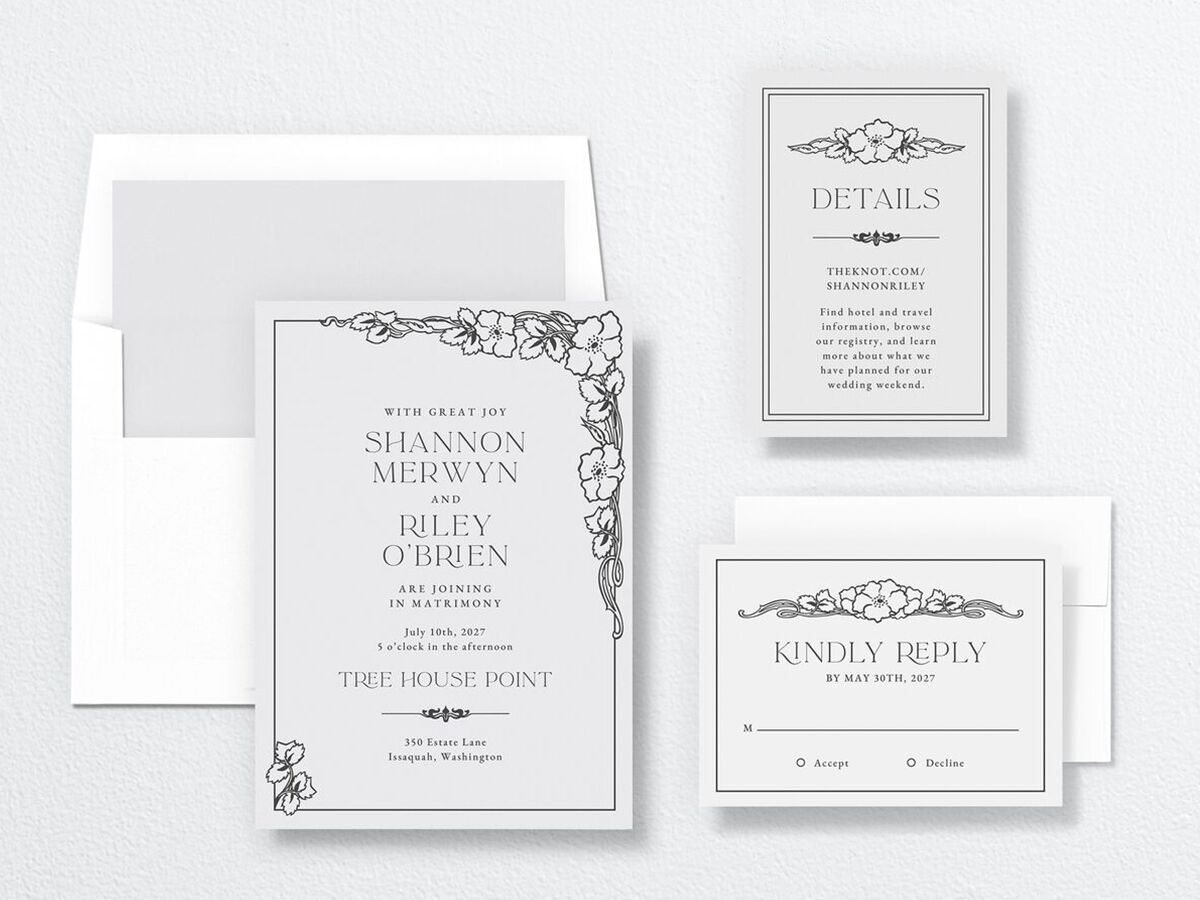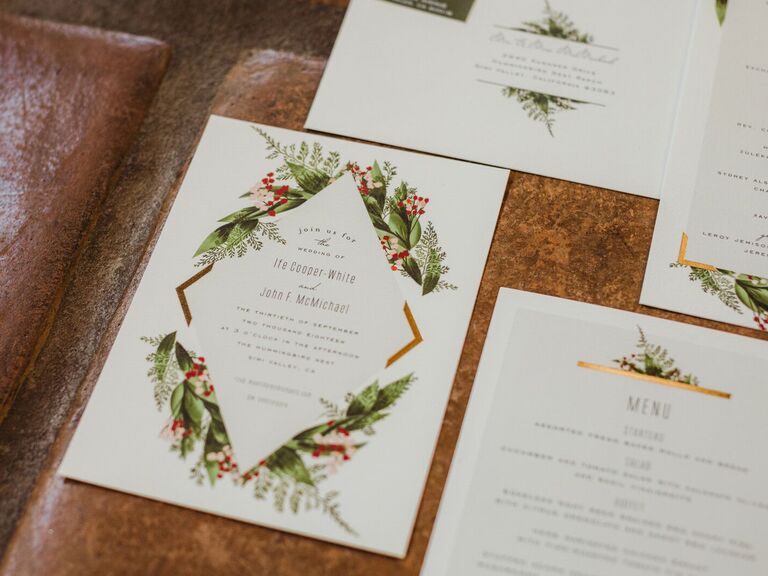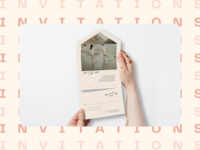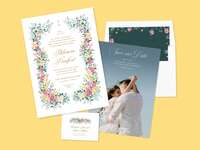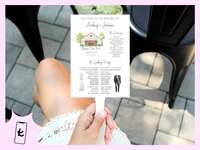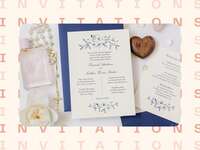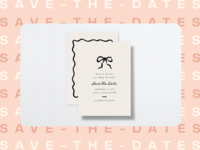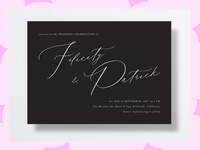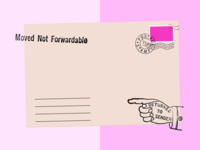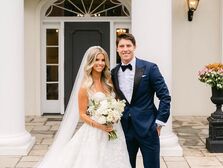The Top Wedding Invitation Tips You Need to Know
Your wedding invitation is your guests' first peek into your wedding day, so you want to make it shine. But with all the options available, it can feel a bit daunting to choose the right invites for your big day—and then make sure that they're properly sent to all of your loved ones. Not sure where to begin? We've got all the wedding invitation tips and FAQs you need to know about this important piece of stationery.
Wedding Invitation FAQs
When should I order wedding invitations?
Your save-the-dates should go out 8 to 10 months before the wedding. It can take anywhere from a few days to a few weeks—or longer, depending how fancy you go—to print them. While your save-the-date cards don't have to match your invites, ordering everything from one stationer can save you money and make the invitation process easier on you. So start scouting stationers 9 to 11 months before the wedding. Aim to order your invitations about four to five months out so they're ready to mail 8 to 10 weeks before the wedding. If you're having a destination wedding or marrying over the holidays, send out your invites even earlier (12 weeks before the wedding).
What is the standard wedding invitation size?
A 4.5-inch-by-6.25-inch rectangular card is the traditional size and shape for wedding invitations. But couples are channeling more playful or modern vibes with circular, scalloped and square invitations. Don't forget to consider that veering away from the standard envelope size can increase the postage—bulky or extra-large invites may cost more to send.
How much do wedding invitations cost?
The price per invite can vary widely—anywhere from $1 to more than $100. It all depends on the design, ink, typeface, printing process, paper and quantity. Top-of-the-line papers, color ink, formal printing techniques (like letterpress and engraving) and custom design will add to your costs, as will decorative extras like envelope liners and multiple enclosures. That's why it's important to research your options ahead of time, so you can pick your priorities, whether it's sophisticated printing and a custom design or multiple enclosures. Also, if you're planning to hire a calligrapher, look into the cost (think: $2 to $8 per envelope) at the same time you're choosing your invitations, so you can account for it in your stationery budget.
What should wedding invitation wording look like?
Learn the rules to wording your invitation. Traditionally, whoever is hosting is listed first on the invitation. Customarily, you should spell everything out, including the time of the ceremony. On classic wedding invitations, there's always a request line after the host's name—something like "so and so request the honor of your presence." The wording can change as the hosting situation does, so make sure to double-check you've added everyone who should be included.
Wedding Invitation Tips
How to Choose Wedding Invitations
Along with listing the location and time of day, the invitation—and, more specifically, its style—hints to the formality of your wedding. You should have an idea of the type of event you're throwing—classic and elegant, casual and relaxed, or glam and modern—before you start shopping for stationery, so you can choose an invitation style that hits the same note. Then browse stationers' websites and others couples' wedding invitations to gather inspiration so you can give your stationer an idea of what you like.
Know Your Colors
Think about your wedding colors too. You may want to incorporate your hues and a motif (if you have one) into your wedding invitations—and then carry them throughout the rest of your wedding paper (like the escort cards, menus and ceremony programs) for a cohesive look. While ivory, cream or white card stock paired with a black or gold font is the classic choice for formal wedding invitations, you can also brighten your invites with colorful or metallic fonts, paper stock, envelopes and liners. Just keep readability in mind when choosing your colors (more on that later).
Make Sure Your Invitations Are Legible
As you consider colors and patterns, don't forget about the text—the information you put on the invitation is the whole point of sending it out in the first place. Your stationer can help, but, in general, avoid light ink on light backgrounds and dark ink on dark backgrounds. Yellow and pastels are tough colors to read, so if you're going with those, make sure the background contrasts enough for the words to pop, or work those colors into the design rather than the text. Also, be wary of hard-to-read fonts like an overly scripted typeface—you don't want to sacrifice readability for pretty letters.
Don't Crowd the Card
List only the key points on your invitation: ceremony time and location, the hosts, your and your future spouse's full names, the dress code (optional) and RSVP information. Trying to squeeze too much onto the invitation card can make it harder to read and it won't look as elegant. Leave things like directions to your wedding venue and details about postwedding activities for your wedding website and/or print them on separate enclosure cards. One piece of information that doesn't belong anywhere on your wedding invitation suite: where you're registered. The only appropriate place to list registry information is on your wedding website.
Get Your Dates Straight
Include your RSVP information on the bottom right corner of your invitation or on a separate RSVP card, and make the deadline no more than three or four weeks after guests receive the invitations. Check with your caterer first to find out when they'll need the final head count. Remember: The more time you give guests to reply, the more likely they are to forget—but you'll need time to put together the seating chart. Plus, your final count may affect the number of centerpieces and other décor elements, which your vendors will need to finalize a few weeks before the wedding.
Have a Pro Address Your Envelopes
When you order your invitations, see if you can take the envelopes home immediately (or as soon as possible). That way, if you're having someone other than your stationer (say, a calligrapher) print the return addresses on your envelopes (most stationers print the return addresses for little or no charge; it's often even included in the suite's price), they can get a head start. While you don't have to hire a calligrapher to address your envelopes, we highly recommend it—it looks beautiful and makes an elegant first impression. Traditionally, addresses are handwritten, so unless you have impeccable handwriting, it's best to leave the envelopes to a pro. If you plan to do them yourselves, tackle the project in a few sittings to avoid sloppiness or mistakes. While using printed labels is an easy (and affordable) option, handwriting each address is not only more formal, it's also more personal. It shows your guests you want them to be at your wedding so much that you took the time to handwrite (or have a calligrapher hand-letter) their name and address on the envelope. But if your penmanship is more like chicken scratch and you don't have the budget for a calligrapher, you can print the addresses from your computer using digital calligraphy software.
Triple-Check the Proof
Before your invitation order is printed, your stationer will send you a proof (either a hard copy or an email attachment of the invite mock-up). Don't just have your partner and mom read it over. Ask your English major friend or a grammar-savvy bridesmaid to check the proof before you okay it. You'd be surprised at the things you may miss (pay special attention to details like wedding date and time and spelling). Borrow a tip from copy editors and read the proof word for word (to yourself and aloud!) from right to left so you don't accidentally gloss over any mistakes.
Count Your Households
You don't need an invitation for every guest. Take a look at your guest list and figure out how many houses need invitations before you give your stationer a number—you might be able to cut your order in half. Cohabiting couples get one invitation; for couples living apart, you can either send one invite to the guest you're closer with (and include both names on the inner and outer envelopes), or you can send out separate invitations. Families get one invitation (addressed to "The Smith Family," for example). The exceptions: Children who don't live at home (like college students) or anyone over 18 who lives at home should get their own invitation.
Order Extra Invitations
It's expensive to go back and print more invitations after the fact. Order enough invitations for your guest list , plus 25 extra in case you need to resend an invitation, want to put some aside as keepsakes (trust us, your moms will want at least a few) or plan on sending invitations to a B-list. Tip: If you have a lengthy B-list, consider ordering a second set of invitations with a later RSVP date. And even if you're hiring a calligrapher to address your invitations, ask for extra envelopes in case of returned invites or addressing mistakes (calligraphers generally require an extra 15 to 20 percent).
Don't Forget the Rest of Your Suite
Order your menus, programs and thank-you notes with your invitations. That way, your stationer can include all of the pieces in one order, which may save you money and time. It's also a good way to ensure all your stationery has a cohesive look, even if you want to vary the design slightly for each element (by switching the dominant color or alternating between two patterns, for example). Also, don't forget those little items like favor tags and welcome bag notes.
Remember Your Thank-Yous
Track RSVPs as they come in using a guest list manager tool or spreadsheet. Include a column where you can note what each guest gives you. Then, as the wedding gifts start rolling in, begin writing your thank-you notes so you don't fall behind. For any presents received before the wedding, you should send a thank-you note within two weeks. For those given on or after the big day, give yourself a month.
Put a Stamp on It
It may seem obvious, but it's easy to forget: If you want wedding guests to mail back their reply cards, include stamped (and addressed) envelopes. That way they don't have to pay for the postage. Traditionally, the return envelopes should be addressed to whoever is hosting the wedding; however, if your parents are technically hosting, but you're keeping track of the guest list, you can use your address instead. And you can find customizable stamps to coordinate with your design at The Knot Shop. Tip: Rates do change from time to time, so check before you add those stamps to make sure you have adequate postage.
Do a Weigh-In
While you probably can't wait to drop those wedding invitations in the mail and check another thing off your to-do list, weighing a sample invitation (enclosures and all) at the post office first could save you many more to-dos later. Trust us, you don't want to deal with the hassle of invitations being returned because of insufficient postage. And while you're at the post office, ask about hand-canceling your invites. This involves a stamp that says your mail is processed (instead of running your invites through the processing machine like regular mail, which could bend or even ruin them). While hand-canceling is free, check with your local post office first to make sure that it has the hand stamp. And keep in mind that while most post offices try to keep hand-canceled mail separate from regular mail, there's no absolute guarantee your invitations won't go through the processing machines. To ensure they don't, you can pay a non-machinable fee to have them hand-processed—it will guarantee your mail will be sorted by hand.
